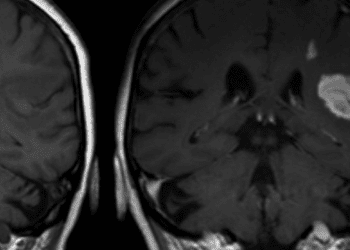Short-term seizure prophylaxis maximizes quality-adjusted life-years in simulated spontaneous intracerebral hemorrhage patients
1. A risk-guided strategy of using short-term secondary prophylaxis in intracerebral hemorrhage patients, and long-term secondary therapy after late seizures, optimized quality-adjusted life-years in most simulated patients with varying risk of early or late seizures and adverse drug reactions (ADRs).
Evidence Rating Level: 5 (Poor)
Study Rundown: Early (≤7 days) seizures are a common complication after a spontaneous intracerebral hemorrhage (sICH) in adults. They are associated with worse outcomes, including further seizures and epilepsy. While the literature suggests anti-seizure medications should not be used due to safety concerns, 40% of US patients receive levetiracetam for prophylactic seizure prevention. Tools for predicting early (2HELPS2B score) and late (CAVE score) seizure risk factors attempt to stratify patients to understand who might benefit from prophylaxis, however, these have yet to be clinically tested. This study aims to use a simulation to optimize the decision to treat with prophylactic anti-seizure medications against safety concerns in patients after sICH. The outcome of interest was quality-adjusted life-years (QALY), which were calculated as an average of patients in the literature with those factors and treatment. For a patient with a low risk of late seizures and average ADR risk and utility (Case 1), the risk-guided strategy was the best at maximizing QALYs. For a patient with a low risk of late seizures and high ADR risk and low ADR utility (Case 2), conservative treatment and risk-guided strategies similarly maximized QALYs. For a patient with a high risk of late seizures and average ADR risk and utility (Case 3), the aggressive treatment strategy yielded best results. For a patient with a high risk of late seizures and high ADR risk and low ADR utility (Case 4), the risk-guided strategy performed best. Overall, the risk-guided strategy performed best for most patients, with aggressive treatment only outperforming it in the specific case of a high-risk seizure patient with average ADRs and anti-seizure drug efficacy. When the model assumed that anti-seizure drugs are ineffective prophylaxis of late seizures, as current guidelines suggest, again the risk-guided strategy was best for the majority of patients, with the conservative strategy only outperforming it in the specific case of low-risk of late seizures and high ADR risk. A major limitation of this study was the use of published data, which may be biased towards positive results and lack of comparisons between drugs and no intervention, for establishing the averages that were used to create the model of the cases. Inevitably the number of variables factored into the model was limited and it did not consider comorbid conditions, surgeries, hematoma expansion or sICH recurrence, all of which are risk factors for seizures. Finally, another limitation is the unreasonable assumption about full adherence to prescribed strategies and medications. These limitations were addressed using sensitivity analysis that altered these estimates to identify how robust the finding was.
Click to read the study in JAMA Neurology
Relevant Reading: Preventing seizure occurrence following spontaneous intracerebral haemorrhage: A systematic review and meta-analysis of seizure prophylaxis
In-Depth [prospective cohort]: This study constructed a decision tree model using average published data that models the quality of life and age-adjusted life-expectancy (together calculating a QALY) after sICH for adult patients without a history of epilepsy or stroke undergoing seizure prophylaxis. The model adjusts for the occurrence of early or late seizures, refractory seizures, anti-seizure drug-related ADRs, anti-seizure drug efficacy, and 2HELPS2B accuracy at predicting early seizure development. Models were generated based on the factors of: 1) primary (before seizure) vs secondary (after seizure) prophylaxis, 2) timing of the event (early vs late seizures), and 3) duration of therapy (1 week [short-term] vs indefinite [long-term]), creating 4 cases. 4 strategies of treatment, including conservative, moderate, and aggressive, and risk-guided, were tested. The simulated patients were treated using each of 4 strategies: 1) Conservative (short-term secondary prophylaxis after early seizures with long-term therapy only after late seizures), 2) Moderate (long-term secondary prophylaxis after any [early or late] seizure), 3) Aggressive (long-term primary [before any seizure] prophylaxis), and 4) Risk-guided (short-term secondary prophylaxis after early seizures in low 2HELPS2B score patients, short-term primary prophylaxis for high 2HELPS2B score patients, and long-term secondary therapy after late seizures). Assumptions of the models included: 1), the lifetime late-seizure risk equals the CAVE-derived risk, necessitated by the lack of data on late-seizure risk after hospitalization; 2) that patients adhere to the strategy despite ADRs; 3) health complications exerted a constant decrease in quality of life (QOL). For Case 1, the low-risk of late seizure patient with average ADR risk and utility, the risk-guided strategy (8.13 QALYs) outperformed conservative (8.08 QALYs), moderate (8.07 QALYs), and aggressive (7.88 QALYs) strategies. For Case 2, the low-risk of late seizure patient with high ADR risk and low ADR utility, conservative treatment was best (2.18 QALYs) compared to risk-guided (2.17 QALYs), moderate (2.09 QALYs), and aggressive (1.15 QALYs) strategies. For Case 3, the high-risk of late seizure patient with average ADR risk and utility, aggressive (9.21QALYs) outperformed risk-guided (8.98 QALYs), moderate (8.93 QALYs), and conservative (8.77 QALYs) strategies. For Case 4, the high-risk of late seizure patient with high ADR risk and low ADR utility, risk-guided strategy (11.53 QALYs) performed best, followed by conservative (11.23 QALYs), moderate (10.93 QALYs), and aggressive (8.08 QALYs) strategies. The sensitivity analyses suggested that risk-guided strategies resulted in the best or similar to the best results compared to the other strategies in most cases. The aggressive strategy only outperformed others in case 3 where late-seizure risk was high while the long-term ADR risk was low. In the sensitivity analysis assuming anti-seizure drugs are ineffective at preventing late seizures, the risk-guided strategy was best for the patients in cases 1, 3, and 4, while the conservative strategy was preferred in case 2.
Image: PD
©2021 2 Minute Medicine, Inc. All rights reserved. No works may be reproduced without expressed written consent from 2 Minute Medicine, Inc. Inquire about licensing here. No article should be construed as medical advice and is not intended as such by the authors or by 2 Minute Medicine, Inc.









